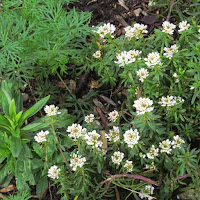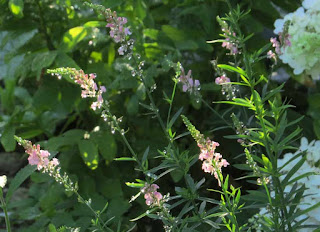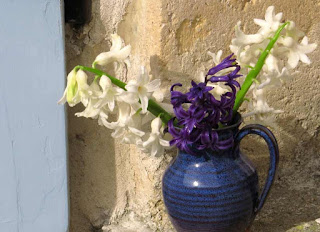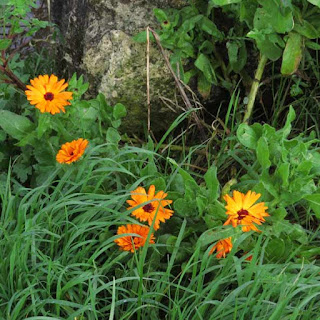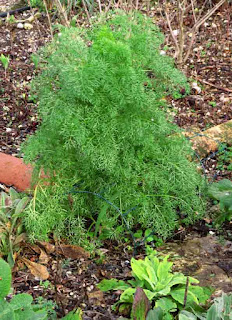"It was one of those March days when the sun shines hot and the wind blows cold: when it is summer in the light, and winter in the shade."
- Charles Dickens
 |
| Hellebores which have seeded and hybridized |
Early spring is a time of huge anticipation... and of almost equal disappointment as you step into the sunny garden only to feel your skin being sliced by a vicious north wind. It's a good idea to take a brisk walk to acclimatise your poor body, before subjecting those dormant muscles to any gardening work in the cold!
 |
| An early hoopoe spotted beside the Gironde estuary |
Fortunately our front garden is south-facing and protected by hedges, so we can often eat lunch on the terrace in March as long as we don't have anyone staying in our adjoining lettings cottage.
In the far corner under a lilac tree, where the sun doesn't penetrate until mid-morning, we have a patch of hellebores which have been left to hybridize over the past few years.
With the sun shining through them from behind they make quite a pretty display even though the flowers are going over after a month in bloom. Left to their own devices, they'll continue to scatter seed until they fill the entire corner, probably blotting out any bulbs in the process!
New Arrivals
It's almost uncanny how migratory birds seem to know when we reach the middle of March. Quite often we see the first swallow on March 15th, but this year it was a pair of hoopoes which arrived on that date. We managed to photograph them taking a break on one of the fishing huts in the Estuary.
 |
| Small tortoiseshell and peacock butterflies |
A day later, whilst walking down our back lane, we came across these two handsome specimens which must have just come out of hibernation - they looked so perfect and unscathed. Tortoiseshells are attracted to nettles, which are already billowing on either side of the path, and both butterflies seemed drawn to the yellow hawkbits currently in flower.
 |
| Penduline tit |
I believe these dainty Penduline tits (Remiz pendulinus) are down on the marshes all year round but we only manage to find them flitting around on bright sunny days, before the trees come into leaf.
Yesterday we scrambled down a cliff and followed a hunting path through the blackthorn in order to catch a glimpse of them. Like longtailed tits, they travel in families and alert you with a high-pitched twittering as they move from branch to branch.
 |
| Pair of nesting storks braving the elements |
Another bird which has taken up permanent residence in recent years is the white stork (Ciconia ciconia).
We have a pair nesting on a platform not far from here and they'll soon be laying their eggs. (As they're both standing up in this picture, I'm assuming they haven't done so already!)
Early Bulbs
 |
| Star of Bethlehem (Ornithogalum umbellatum) |
I think most gardeners are happy for bulbs to naturalise where they don't interfere too much with other plants, and to that end we prefer using the smaller species tulips which can be slotted in between pinks, geraniums, herbs and other sun-lovers.
 |
| Tulipa clusiana |
Next to the grey-green foliage of dianthus or lavender it looks very classy.
Another species tulip which comes out even earlier, with several flower-heads on its stem, is Tulipa turkestanica. Reaching a height of only 20cm, it's eye-catching at the front of the border and will naturalise easily in a free-draining soil.
 |
| Tulipa turkestanica with a naturally sunny dsposition! |
Sallows or Osiers?
 |
| A type of Salix... but which one? |
Much as I love trees, and particularly those which provide us with catkins in spring, I must admit to being ignorant as to the different types of pussy willow growing along the streams and channels near here.
The one on the left closely resembles the Great Sallow (Salix caprea) as illustrated in my English book of trees. Sallows are broad-leaved willows, it says, which are shade-tolerant and less restricted to wet places than most of the Salix family. (A glance at Google Images confirms that there are several varieties suitable for the garden.)
This one on the right might be a male version of the above Salix... in time the catkins will get fluffier as they develop. The only way I'll really be able to identify these is by checking out the leaves when they unfurl.
If it turns out to have long narrow leaves, then it's probably some kind of osier. Confused...??
 |
| Shining filaments of pussy willow |
All I know is they make a pretty picture on a sunny day, especially with the light behind them.
What I find remarkable - and rather poignant - is how pussy willow and other kinds of blossom continue to open as nature intended even when the parent tree has been cruelly uprooted and is lying on its side. Fallen trees seem determined to seed themselves no matter what.
Back garden in mid-March
 |
| Mixed border with a rather yellowed diascia in the foreground. Bought as an annual in the UK, it survives winter planted out - even producing flowers. |
It's noticeable that perennials are spreading out day by day and less soil is visible between them. I still keep plucking out the odd weed as it's so much easier to do when they're tiny and shallow-rooted.
If we had more ready-made compost, then now would be the time to spread it between plants; but we're waiting for a mild day with no wind in order to turn the compost heap and take out some fresh stuff.
In the meantime, where leaves are looking a bit yellow in our limey soil, I'll mix up a solution of chelated iron to water in. This is particularly important for some shrubs like roses and hydrangeas which are susceptible to yellowing.
Out on the Marais...
Wind passes over the reedbeds as if they were a pale ocean lapping at the base of those mysterious chalk cliffs, known as les falaises mortes.
A pair of horses were left out to fend for themselves without shelter over the entire winter and we worried about their welfare when high tides turned much of their grassland into churned up mud.
However, they seem to have emerged from the long cold nights looking quite fit and healthy - if in need of a good brushing!
These extensive reedbeds are a sensitive environment, carefully protected by the government and other agencies like the LPO - our equivalent of the RSPB - who send out a team in April to ring certain birds and take an inventory.
Photographing small birds in the reeds is quite a challenge and we've yet to catch sight of the bluethroats which arrive in April. Maybe this year...?
A pair of horses were left out to fend for themselves without shelter over the entire winter and we worried about their welfare when high tides turned much of their grassland into churned up mud.
However, they seem to have emerged from the long cold nights looking quite fit and healthy - if in need of a good brushing!
These extensive reedbeds are a sensitive environment, carefully protected by the government and other agencies like the LPO - our equivalent of the RSPB - who send out a team in April to ring certain birds and take an inventory.
Photographing small birds in the reeds is quite a challenge and we've yet to catch sight of the bluethroats which arrive in April. Maybe this year...?
 |
| Blackthorn producing clouds of creamy blossom over the marais |






